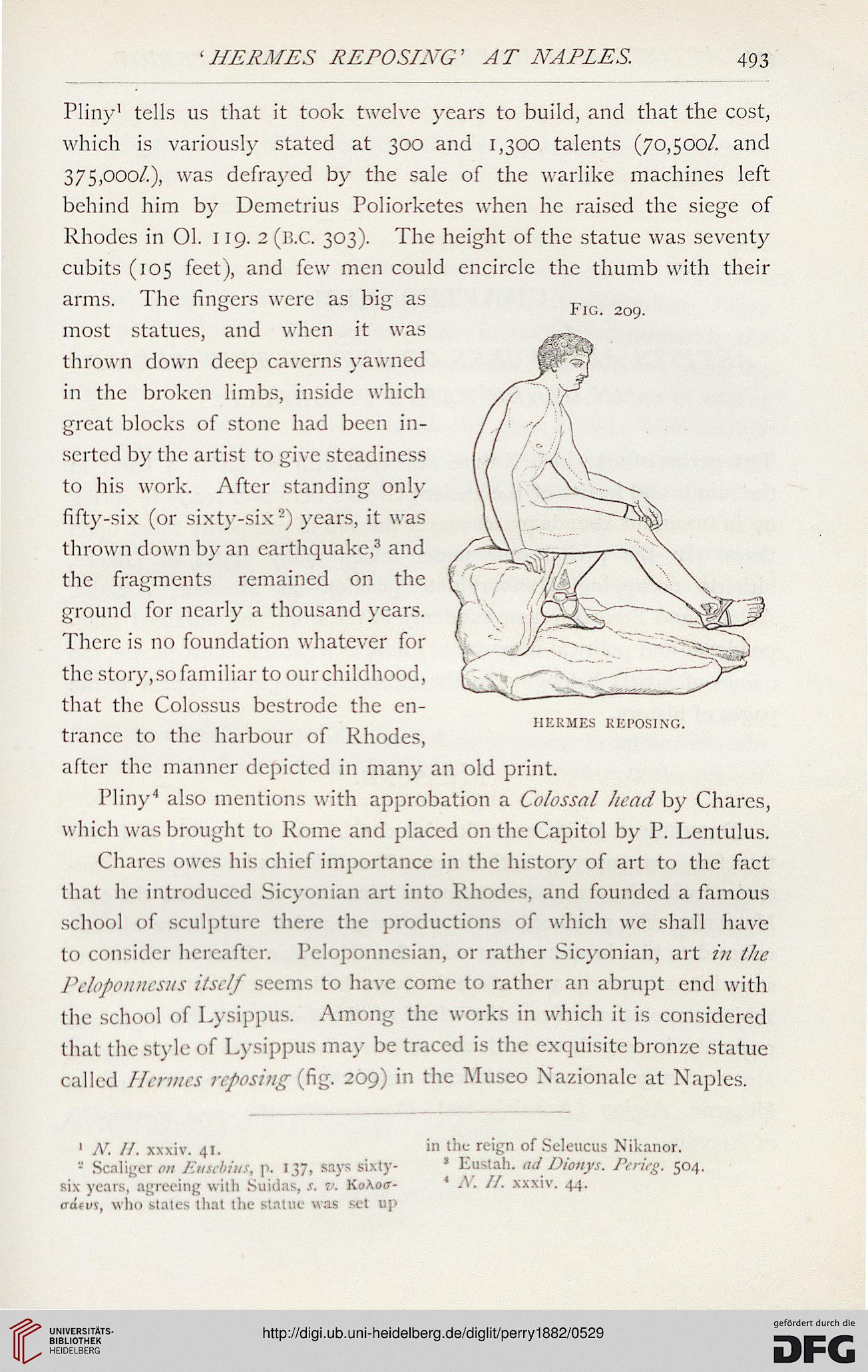493
Pliny1 tells us that it took twelve years to build, and that the cost,
which is variously stated at 300 and 1,300 talents (70,500/. and
375,000/.), was defrayed by the sale of the warlike machines left
behind him by Demetrius Poliorketes when he raised the siege of
Rhodes in 01. 119. 2 (B.C. 303). The height of the statue was seventy
cubits (105 feet), and few men could encircle the thumb with their
arms. The finders were as big as „
° 0 f ig. 209.
most statues, and when it was
thrown down deep caverns yawned
in the broken limbs, inside which
great blocks of stone had been in-
serted by the artist to give steadiness
to his work. After standing only
fifty-six (or sixty-six2) years, it was
thrown down by an earthquake,3 and
the fragments remained on the
ground for nearly a thousand years.
There is no foundation whatever for
the story,so familiar to ourchildhood,
that the Colossus bestrode the en-
. . , , hermes reposing.
trance to the harbour of Rhodes,
after the manner depicted in many an old print.
Pliny4 also mentions with approbation a Colossal head by Chares,
which was brought to Rome and placed on the Capitol by P. Lentulus.
Chares owes his chief importance in the history of art to the fact
that he introduced Sicyonian art into Rhodes, and founded a famous
school of sculpture there the productions of which we shall have
to consider hereafter. Pcloponncsian, or rather Sicyonian, art in the
Peloponnesus itself seems to have come to rather an abrupt end with
the school of Lysippus. Among the works in which it is considered
that the style of Lysippus may be traced is the exquisite bronze statue
called Hermes reposing (fig. 209) in the Museo Nazionale at Naples.
1 fft //, xxxiv. 41. in the- reign of Seleucus Nikanor.
' Scaliger on Kmchius, p. 137, says sixty- * Eustah. ml Dionys. Pcricg. 504.
six years, agreeing with Suiilas, s. v. KoAoff- 4 A. //. xxxiv. 44.
(rctft/s, wIki slates lliat the statue was sel up
Pliny1 tells us that it took twelve years to build, and that the cost,
which is variously stated at 300 and 1,300 talents (70,500/. and
375,000/.), was defrayed by the sale of the warlike machines left
behind him by Demetrius Poliorketes when he raised the siege of
Rhodes in 01. 119. 2 (B.C. 303). The height of the statue was seventy
cubits (105 feet), and few men could encircle the thumb with their
arms. The finders were as big as „
° 0 f ig. 209.
most statues, and when it was
thrown down deep caverns yawned
in the broken limbs, inside which
great blocks of stone had been in-
serted by the artist to give steadiness
to his work. After standing only
fifty-six (or sixty-six2) years, it was
thrown down by an earthquake,3 and
the fragments remained on the
ground for nearly a thousand years.
There is no foundation whatever for
the story,so familiar to ourchildhood,
that the Colossus bestrode the en-
. . , , hermes reposing.
trance to the harbour of Rhodes,
after the manner depicted in many an old print.
Pliny4 also mentions with approbation a Colossal head by Chares,
which was brought to Rome and placed on the Capitol by P. Lentulus.
Chares owes his chief importance in the history of art to the fact
that he introduced Sicyonian art into Rhodes, and founded a famous
school of sculpture there the productions of which we shall have
to consider hereafter. Pcloponncsian, or rather Sicyonian, art in the
Peloponnesus itself seems to have come to rather an abrupt end with
the school of Lysippus. Among the works in which it is considered
that the style of Lysippus may be traced is the exquisite bronze statue
called Hermes reposing (fig. 209) in the Museo Nazionale at Naples.
1 fft //, xxxiv. 41. in the- reign of Seleucus Nikanor.
' Scaliger on Kmchius, p. 137, says sixty- * Eustah. ml Dionys. Pcricg. 504.
six years, agreeing with Suiilas, s. v. KoAoff- 4 A. //. xxxiv. 44.
(rctft/s, wIki slates lliat the statue was sel up




